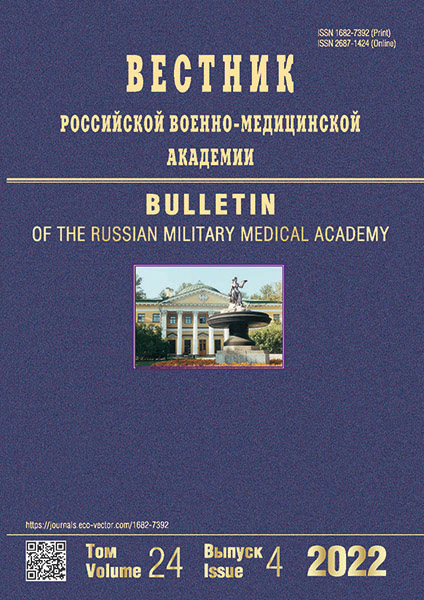Lifetime morphological characteristics of the LIV-LV intervertebral disc in young and middle-aged adults
- 作者: Priymak M.A.1, Gaivoronsky A.I.2, Gaivoronsky I.V.2,3,4, Nichiporuk G.I.2,3, Gaivoronskaya M.G.3,4, Goriacheva I.A.2,3
-
隶属关系:
- 1586th Military Clinical Hospital
- Military Medical Academy of S.M. Kirov
- Saint Petersburg State University
- Scientific Medical Research Center of V.A. Almazova
- 期: 卷 24, 编号 4 (2022)
- 页面: 689-696
- 栏目: Original Study Article
- ##submission.dateSubmitted##: 31.08.2022
- ##submission.dateAccepted##: 15.11.2022
- ##submission.datePublished##: 04.01.2023
- URL: https://journals.eco-vector.com/1682-7392/article/view/110717
- DOI: https://doi.org/10.17816/brmma110717
- ID: 110717
如何引用文章
详细
Morphoscopic and morphometric characteristics of the LIV–LV intervertebral disc were assessed according to magnetic resonance images of the lumbar spine of 90 patients (66 men, 24 women). The morphometric parameters of the LIV–LV intervertebral disc and nucleus pulposus were compared between young (18–44 years old) and middle-aged (45–60 years old) adults and in groups determined by sex and body type. In addition, morphoscopic characteristics, namely, the shape of the intervertebral disc and nucleus pulposus in the axial plane, were evaluated. Results. In normal intervertebral disc, LIV–LV on the axial section most often presents in a kidney-shaped (51%), elliptical (45%), and round (4%) form. The LIV–LV nucleus pulposus normally has an oval (50%), kidney (45%), and less often a lemniscate (5%) shape. The shape and individual morphometric parameters of the intervertebral disc and nucleus pulposus of the LIV–LV segment have significant sex differences. Thus, the most lateral height of the intervertebral disc on the right and left, anteroposterior size and area of the intervertebral disc, and anteroposterior size, width, and area of the nucleus pulposus are significantly larger in men than in women. When assessing the influence of body type on intervertebral disc structural features, no significant differences in its shape were found between asthenics, normo- and hypersthenics, while individual dimensions (intervertebral disc height in the center and its dorsal height) were significantly larger in hypersthenics. The kidney-shaped form of the nucleus pulposus was significantly more common in asthenics and the oval form in hypersthenics, whereas the morphometric parameters of the nucleus pulposus did not significantly differ between extreme body types. Statistically significant differences in the shape of the nucleus pulposus were found between age groups. The results of the analysis of morphometric characteristics revealed the intervertebral disc height tended to decrease in middle-aged people compared with young people. The results can be used in planning spine surgery and designing artificial intervertebral discs.
全文:
作者简介
Maxim Priymak
1586th Military Clinical Hospital
Email: boec.87@inbox.ru
ORCID iD: 0000-0003-4984-9526
SPIN 代码: 6826-2947
senior resident
俄罗斯联邦, PodolskAlexei Gaivoronsky
Military Medical Academy of S.M. Kirov
Email: solnushko12@mail.ru
ORCID iD: 0000-0003-1886-5486
SPIN 代码: 7011-6279
doctor of medical sciences, professor
俄罗斯联邦, Saint PetersburgIvan Gaivoronsky
Military Medical Academy of S.M. Kirov; Saint Petersburg State University; Scientific Medical Research Center of V.A. Almazova
Email: i.v.gaivoronsky@mail.ru
ORCID iD: 0000-0002-7232-6419
SPIN 代码: 1898-3355
doctor of medical sciences, professor
俄罗斯联邦, Saint Petersburg; Saint Petersburg; Saint PetersburgGennadii Nichiporuk
Military Medical Academy of S.M. Kirov; Saint Petersburg State University
Email: nichiporuki120@mail.ru
ORCID iD: 0000-0001-5569-7325
SPIN 代码: 3532-1203
candidate of medical sciences, associate professor
俄罗斯联邦, Saint Petersburg; Saint PetersburgMaria Gaivoronskaya
Saint Petersburg State University; Scientific Medical Research Center of V.A. Almazova
编辑信件的主要联系方式.
Email: solnushko12@mail.ru
ORCID iD: 0000-0003-4992-9702
SPIN 代码: 2357-5440
doctor of medical sciences, associate professor
俄罗斯联邦, Saint Petersburg; Saint PetersburgInga Goriacheva
Military Medical Academy of S.M. Kirov; Saint Petersburg State University
Email: smoriarti@yandex.ru
ORCID iD: 0000-0003-3064-7596
SPIN 代码: 6705-8553
candidate of medical sciences, associate professor
俄罗斯联邦, Saint Petersburg; Saint Petersburg参考
- Fehlings MG, Tetreault L, Nater A, et al. The Aging of the global population: the changing epidemiology of disease and spinal disorders. Neurosurgery. 2015;77(4):1–5. doi: 10.1227/NEU.000000000000095
- Pfirrmann CW, Metzdorf A, Elfering A, et al. Effect of aging and degeneration on disc volume and shape: A quantitative study in asymptomatic volunteers. J Orthop Res. 2006;24(5):1086–1094. doi: 10.1002/jor.20113
- Siemionow K, An H, Masuda K, et al. The effects of age, sex, ethnicity, and spinal level on the rate of intervertebral disc degeneration: a review of 1712 intervertebral discs. Spine (Phila Pa 1976). 2011;36(17):1333–1339. doi: 10.1097/BRS.0b013e3181f2a177
- Byval’cev VA, Stepanov IA, Kalinin AA, et al. Diffusion-weighted magnetic resonance imaging in the diagnosis of intervertebral disc degeneration in the lumbosacral spine. Journal of Radiology and Nuclear Medicine. 2016;97(6):357–364. (In Russ.). doi: 10.20862/0042-4676-2016-97-6-357-364
- Jeffrey Ross S, Kevin Moore R. Radiation diagnostics. Spine. Moscow: Izd. Panfilova; 2018. 1184 p. (In Russ.)
- Zavislyak OA. Mofometricheskaya kharakteristika poyasnichnogo otdela pozvonochnogo stolba vzroslogo cheloveka v magnitno-rezonansnom izobrazhenii [dissertation]. Saint Petersburg; 2003. 15 p. (In Russ.).
- Fyllos AH, Arvanitis DL, Karantanas AH, et al. Magnetic resonance morphometry of the adult normal lumbar intervertebral space. Surg Radiol Anat. 2018;40(9):1055–1061. doi: 10.1007/s00276-018-2048-7
- Karabekir HS, Gocmen-Mas N, Edizer M, et al. Lumbar vertebra morphometry and stereological assesment of intervertebral space volumetry: a methodological study. Ann Anat. 2011;193(3):231–236. doi: 10.1016/j.aanat.2011.01.011
- van Houwen EB, Baron P, Veldhuizen AG, et al. Geometry of the intervertebral volume and vertebral endplates of the human spine. Ann Biomed Eng. 2010;38(1):33–40. doi: 10.1007/s10439-009-9827-6
- Vaccaro AR, Baron IM. Surgical anatomy. Operational technology. Moscow: Izd. Panfilova; 2015. 440 p. (In Russ.).
- Chertkov AK. Lumbar disc endoprosthetics neurosurgery. Moscow: MIA; 2011. 160 p. (In Russ.).
- Näther P, Kersten JF, Kaden I, et al. Distribution Patterns of Degeneration of the Lumbar Spine in a Cohort of 200 Patients with an Indication for Lumbar MRI. Int J Environ Res Public Health. 2021;19(6):3721. doi: 10.3390/ijerph19063721
- Zhurkin KI. Topograficheskaya i polovaya izmenchivost’ vysoty mezhpozvonochnykh diskov i tel pozvonkov poyasnichnogo otdela pozvonochnika bez vyyavlennykh degenerativno-distroficheskikh izmenenii i s priznakami osteokhondroza. Bulletin of Medical Internet Conferences. 2016;6(5):712–717. (In Russ.).
- Emkuzhev OL. Izmenchivost’ morfotopometricheskikh parametrov poyasnichnogo otdela pozvonochnogo stolba [abstract dissertation]. Saratov; 2016. 22 p. (In Russ.).
- Karatieieva SY, Slobodian OM, Honchar HI, et al. Establishment of types of the constitutions in students-athletes and in students-medicists with their further analysis. WIAD LEK. 2022;75(4):955–958. doi: 10.36740/WLEK202204206
- Singh T, Parr WCH, Choy WJ, et al. Three-dimensional morphometric analysis of lumbar vertebral end plate anatomy. World Neurosurg. 2020;135:321–332. doi: 10.1016/j.wneu.2019.11.158
补充文件






